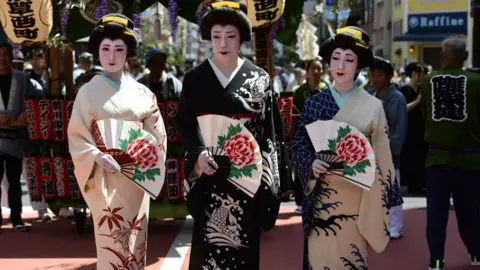Kim Kardashian West's Kimono underwear meets Japanese backlash
 Getty Images
Getty ImagesKim Kardashian West has angered people in Japan with the launch of her new shapewear brand, Kimono Intimates.
The reality star said the label, launched on Tuesday, is inclusive and "celebrates and enhances the shape and curves of women".
But Japanese people on social media have said the trademarked brand disrespects traditional clothing.
The kimono, a loose long-sleeved robe typically tied with a sash, dates back to 15th Century Japan.
Considered the national dress of Japan, it is now mostly worn during special occasions.
"We wear kimonos to celebrate health, growth of children, engagements, marriages, graduations, at funerals. It's celebratory wear and passed on in families through the generations," one Japanese woman, Yuka Ohishi, told the BBC.
"[This] shapewear doesn't even resemble a kimono - she just chose a word that has Kim in it - there's no respect to what the garment actually means in our culture."
Allow X content?

Kardashian West sought to trademark the Kimono brand last year in the US. She has also filed trademarks for "Kimono Body", "Kimono Intimates" and "Kimono World".
The underwear, designed to create smooth lines under clothing, is available in several different colours.
Kardashian West said on Twitter that there were "so many times I couldn't find a shapeware color that blended with my skin tone so we needed a solution for all of this".

Fear and alarm in Japan
By Yuko Kato, BBC News, Tokyo
Kimono - the literal translation is 'something to wear' - are usually meticulously crafted by experts. They are mostly worn on special occasions, but for some they are worn whenever they feel like dressing up a bit and making an extra effort.
For many Japanese people, wearing a kimono is a way of maintaining a connection with history, culture and one's sense of being Japanese as lifestyles and wardrobes become more Westernised.
Some see Kim Kardashian West's product as stripping the Japanese meaning from the word, and there are fears this could have dire consequences on a struggling traditional industry.
If the star was marketing a line of loose wrap-around gowns, sometimes called kimonos in the West, then the reaction may have been one of mild resignation since it bears some similarity with its namesake.
But a Japanese kimono is a very specific thing - not lingerie - and trying to trademark the ubiquitous word has been seen by many as rather alarming. People have been posting photos of actual Japanese kimonos, stressing: "No, kimono is not underwear."

Many people have taken issue with the fact she is trying to trademark a word of huge significance in Japanese culture. Others were annoyed that the traditional garment now shares the same name as an intimate wear brand.
Some have been tweeting with the hashtag #KimOhNo.
Allow X content?

Allow X content?

Allow X content?

Allow X content?

Others feared people might start to associate the kimono with Kardashian West, rather than Japan.
"I think Kim has so much influence on pop culture, I fear there will be people who only know the word kimono as her brand," said Ms Ohishi.
"I imagine it will have an effect on search results, hashtags, if this brand becomes as powerful as her other ventures."
The latest label by Kardashian West touts itself as a size and diversity inclusive brand, carrying sizes from XXS to 4XL. It's also available in nine shades.
But one kimono expert said it was ironic that it identifies itself with a garment that is the opposite of shape wear.
 Sato Kimono/Twitter
Sato Kimono/Twitter"The [aesthetic] of the kimono is graceful, elegant and gentle. It is not overtly revealing or figure-hugging. It wraps the wearer so they are not exposed," Prof Sheila Cliffe from the Jumonji Women's University told the BBC.
"If I made a bra and called it a sari... some people would be very annoyed. It shows extreme disrespect... [the Kimono] is an expression of Japanese identity. That word does not belong to Kim Kardashian."
